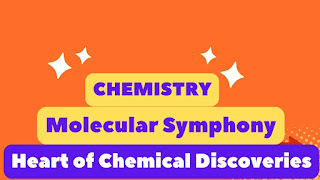The Molecular Symphony
Chemistry, like a captivating symphony, is a journey into the heart of molecular discoveries that compose the essence of our world. In this exploration, we delve into the intricacies of the molecular symphony, uncovering the harmonies of chemical elements and the melodies of transformative reactions.
Introduction: The Enchanting Prelude of Chemistry
The molecular symphony begins with an enchanting prelude, drawing us into the world of chemical discoveries. Harmony of Elements: Exploring the Periodic Table serves as our opening movement, tracing the historical development of the Periodic Table. This iconic arrangement of elements guides our exploration, providing a roadmap to the diverse and captivating world of chemistry.
Harmony of Elements: Exploring the Periodic Table
As we navigate the composition of elements, we encounter the graceful Dance of Electrons: Unraveling Chemical Bonds. Covalent bonds, where electrons are shared, and ionic bonds, where electrons are exchanged, create the intricate choreography of molecular interactions. It's a dance that shapes the structure and behavior of matter, revealing the beauty of chemical connections.
Dance of Electrons: Unraveling Chemical Bonds
The subatomic realm introduces a serenade in Subatomic Serenade: Understanding Quantum Mechanics. Here, we meet the electron, proton, and neutron—the fundamental particles orchestrating the molecular symphony. Quantum mechanics, the silent conductor behind the scenes, dictates the behavior of these particles, bringing order to the molecular composition.
Subatomic Serenade: Understanding Quantum Mechanics
Transitioning between scales, Macro and Micro: Navigating Different Perspectives highlights the significance of viewing chemical phenomena from both macroscopic and microscopic angles. Like appreciating a painting up close and from a distance, this dual perspective enriches our comprehension of chemical processes.
Macro and Micro: Navigating Different Perspectives
In the chemical symphony, equations play a crucial role, creating a euphonic harmony in Equations in Euphony: Balancing Chemical Reactions. Balancing chemical equations and applying stoichiometry are the musical notes that ensure a precise and balanced performance, where reactants and products dance in perfect coordination.
Equations in Euphony: Balancing Chemical Reactions
Laboratories become the crescendo of our journey in Laboratory Crescendo: Essential Equipment and Safety Measures. Here, we encounter the instruments of chemical exploration and learn the importance of safety measures. It's a stage where chemical reactions unfold, and safety is the key to a flawless performance.
Laboratory Crescendo: Essential Equipment and Safety Measures
Catalysts take center stage in Catalysts: Conductors of Alchemical Harmony, accelerating reactions and enhancing the tempo of the chemical symphony. Chemical kinetics becomes the dynamic force behind the scenes, influencing the speed and efficiency of reactions.
Catalysts: Conductors of Alchemical Harmony
The Earth's composition becomes a geological crescendo in Earth's Composition: Chemistry of Geological Crescendos. Rocks and minerals reveal the chemical processes that have shaped the planet over millennia, turning the Earth into a grand theater of chemical transformations.
Earth's Composition: Chemistry of Geological Crescendos
Life itself becomes a biochemical overture in Biochemical Overture: Harmony in the Chemistry of Life. DNA, the maestro of genetic information, conducts the symphony of life, while enzymes act as the skilled musicians guiding biochemical reactions with precision.
Biochemical Overture: Harmony in the Chemistry of Life
Nanotechnology introduces miniature movements in the chemical score in Nanotechnology: Miniature Movements in the Chemical Score. Here, chemistry becomes the composer of advanced materials and technologies, orchestrating a symphony at the nanoscale.
Nanotechnology: Miniature Movements in the Chemical Score
The molecular symphony adopts an eco-friendly melody in Green Chemistry: An Eco-Friendly Melody. Principles of green chemistry guide us towards sustainable practices, ensuring that the chemical performance benefits both humanity and the environment.
Green Chemistry: An Eco-Friendly Melody
Beyond laboratories and classrooms, chemistry influences various industries, composing a symphony of innovation in Chemical Innovation: Composing Industry Advancements. From pharmaceuticals to agriculture, chemistry drives advancements that resonate across diverse sectors.
Chemical Innovation: Composing Industry Advancements
The symphony evolves into modern crescendos in Modern Crescendos: Emerging Trends in Chemical Exploration. Current trends and research showcase the dynamic nature of chemical exploration, hinting at future movements in the molecular symphony.
Modern Crescendos: Emerging Trends in Chemical Exploration
In conclusion, Applauding the Marvels of the Molecular Symphony is not just a reflection on the journey through chemistry but an invitation to appreciate the ongoing performance. The molecular symphony, with its diverse movements and harmonies, continues to captivate and redefine our understanding of the molecular world.
Conclusion: Applauding the Marvels of the Molecular Symphony
FAQs
Q1: How does the Periodic Table guide chemical exploration?
The Periodic Table organizes elements based on their properties, providing a roadmap for predicting their behavior and relationships.
Q2: What is the significance of balancing chemical equations?
Balancing chemical equations ensures a precise and balanced performance of chemical reactions, where reactants and products are in perfect coordination.
Q3: How do catalysts influence chemical reactions?
Catalysts accelerate reactions by lowering the activation energy required for the reactions to occur, enhancing the tempo of the chemical symphony.
Q4: What are some examples of sustainable practices in green chemistry?
Sustainable practices in green chemistry include using renewable resources, minimizing waste, and designing environmentally friendly processes.
Q5: How does chemistry contribute to advancements in various industries?
Chemistry drives innovations in industries such as pharmaceuticals and agriculture, influencing the development of new products and technologies.


0 Comments
Post a Comment